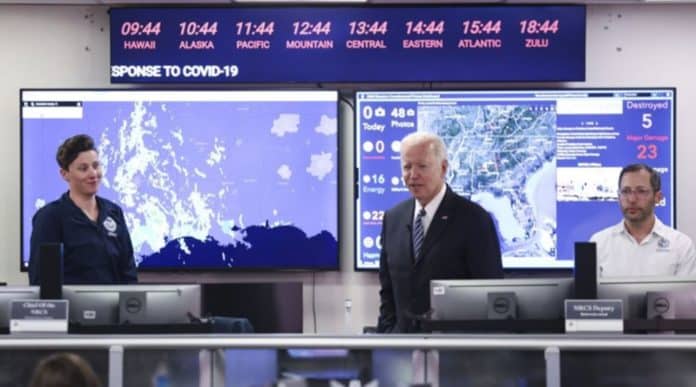
May 25 (UPI) — President Joe Biden’s administration is doubling federal funding to better prepare for hurricanes and other severe weather events and asking NASA to collect more climate data, the White House said Monday.
The announcement came ahead of Biden’s visit Monday to Federal Emergency Management Agency headquarters to receive a briefing on the 2021 Atlantic hurricane season.
During the FEMA visit, Biden will outline $1 billion in added funding to help communities prepare for severe weather and other disasters. The money will shift the federal focus from “reactive disaster spending” to research-supported community preparedness, the White House said.
The money will go to the Building Resilient Infrastructure and Communities program that helps areas prepare in advance for natural disasters, such as hurricanes and wildfires. A portion of the money will focus on disadvantaged areas.
NASA will also launch a new mission for an Earth System Observatory to better understand and track how climate change is impacting weather and communities.
“As the number of extreme weather events increases due to climate change, the ability to forecast and monitor natural disasters is integral for the nation’s preparation, mitigation, and resilience,” the White House said.
The Atlantic hurricane season technically begins June 1, but it’s already produced one named storm — Subtropical Storm Ana, which took shape in the Atlantic Ocean east of Bermuda over the weekend.
Now a post-tropical cyclone, Ana gradually moved over open water but didn’t make landfall. It’s forecast to dissipate Monday as it moves northeast and farther out into the open ocean, the National Hurricane Center said.
With Ana’s formation, the Atlantic hurricane season started early for the seventh year in a row.
Forecasters are anticipating a hurricane season that’s above normal in 2021 — 17 named storms, of which eight will become hurricanes. Four hurricanes are expected to be strong enough to be considered major hurricanes — Category 3 or higher.
The average Atlantic hurricane season season sees about 12 named storms, about half of which are hurricanes, and three become major hurricanes.
Biden will be briefed at FEMA headquarters at 1:30 p.m. EDT, the White House said. He faces another disruptive hurricane season in the United States particularly in the Gulf states and along the eastern seaboard.
A forecast by Colorado State University last month estimates a near 70% chance that at least one major hurricane will make landfall on a U.S. coastline. There’s also a 58% chance of a major hurricane tracking into the Caribbean.
Forecasters say the expected above-normal season is partly the result of a lack of an El Niño system this year and warmer waters in the Atlantic.
The next name on the list after Ana is Bill, followed by Claudette, Danny, Elsa, Fred, Grace, Henri, Ida, Julian, Kate, Larry, Mindy, Nicholas, Odette, Peter, Rose, Sam, Teresa, Victor and Wanda.
A system becomes a named storm when it reaches sustained winds of 39 mph (subtropical and tropical storms) and it becomes a hurricane when sustained speeds reach 74 mph.
A year ago, the Atlantic hurricane season began even earlier. Tropical Storm Arthur formed southeast of Florida on May 16, and Tropical Storm Bertha followed on May 27 off the Georgia coast.
Last season ended as the busiest on record, with 30 named systems. A record 12 made landfall in the United States. Seven of the storms killed 86 people and caused $40 billion in damage. Over the past two decades, tropical storms and hurricanes have killed more than 6,000 Americans and caused close to $900 billion in damage.
There were so many storms last year that the Greek alphabet was used to name nine systems once the pre-designated list of names for the season had been exhausted. The National Hurricane Center has decided to no longer use this naming convention.






